You’ll find that Eastern Oklahoma’s humid subtropical climate creates unique opportunities for native plant gardening, but success depends on understanding which species actually thrive in your specific conditions. The region’s clay-heavy soils, irregular rainfall patterns, and temperature swings between 20°F winters and 95°F summers eliminate many popular garden choices. However, certain wildflowers, trees, and shrubs have adapted perfectly to these challenges over thousands of years, offering you low-maintenance options that support local wildlife while creating stunning seasonal displays.
Contents
- 1 Eastern Oklahoma’s Soil and Weather
- 2 Best Wildflowers for Eastern Oklahoma
- 3 Native Shade Trees
- 4 Native Shrubs for Wildlife Habitat
- 5 Selecting the Right Native Plants for Your Garden
- 6 Frequently Asked Questions
- 6.1 How Long Do Native Plants Take to Establish in Eastern Oklahoma?
- 6.2 What Time of Year Is Best for Planting Native Species?
- 6.3 Do Native Plants Require Fertilizer or Special Soil Amendments?
- 6.4 How Much Do Native Plants Typically Cost Compared to Non-Natives?
- 6.5 Can Native Plants Survive Oklahoma’s Extreme Weather Events Like Ice Storms?
Eastern Oklahoma’s Soil and Weather
When you’re planning a native plant garden in eastern Oklahoma, understanding your soil and climate sets the foundation for success. You’ll encounter three main soil types: Ultisols in the far east, sandy Alfisols in Cross Timbers areas, and Entisols along floodplains. Each affects moisture retention differently.
Your region receives 40-50 inches of annual rainfall, creating a humid subtropical climate. Sandy subsoils drain well but limit water storage, while clay soils hold moisture longer. Spring thunderstorms provide abundant water, but summer droughts stress plants.
Understanding your specific soil composition helps you choose natives that’ll thrive naturally. Medium-textured soils like loams and silt loams in your area provide the ideal balance for most native plant growth.
Best Wildflowers for Eastern Oklahoma
Eastern Oklahoma’s diverse wildflowers offer year-round beauty while supporting local ecosystems. These native species provide pollinator habitat, adapt to various conditions, and contribute both aesthetic and conservation value. Many wildflowers thrive in poor soil conditions, making them ideal for challenging garden sites where other plants might struggle.
Purple Prairie Clover

Purple Prairie Clover (Dalea purpurea) is an exceptional native wildflower perfectly suited for Eastern Oklahoma landscapes. This tough perennial legume produces stunning rose-purple cylindrical flower heads from June through September, creating extended seasonal interest. With its distinctive citrus-scented foliage and deep taproot system, it thrives in challenging conditions while providing valuable ecological benefits.
As a late successional prairie plant, Purple Prairie Clover excels in naturalized settings, prairie restorations, and ornamental gardens. Its drought tolerance and non-invasive nature make it ideal for slopes, mass plantings, and roadside applications. The plant serves as an important pollinator host and nitrogen-fixing species, contributing considerably to ecosystem health while offering high-protein forage for wildlife. This species also functions as effective ground cover to help prevent soil erosion in prairie environments.
- Hardiness: Zones 3-8, extremely cold hardy and heat tolerant
- Light: Full sun to partial sun
- Water: Low to moderate water needs, drought tolerant once established
- Soil: Well-drained sandy loam, tolerates rocky and limestone soils
- Fertilizer: None required, fixes its own nitrogen as a legume
- Pest/Disease Resistance: Excellent resistance to pests and diseases
- Growth Rate: Moderate to slow establishment, long-lived once mature
Black-Eyed Susan
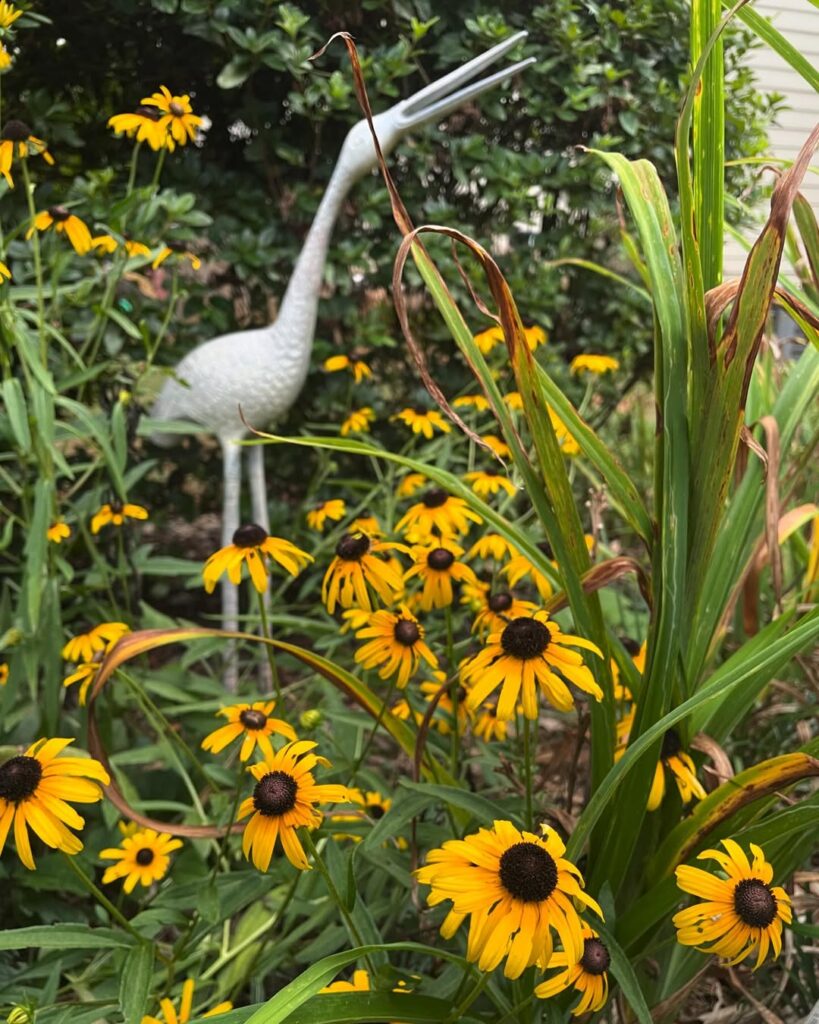
Black-eyed Susan is a beloved native wildflower that brings vibrant summer color to Eastern Oklahoma gardens. This adaptable plant features cheerful yellow petals surrounding dark brown centers, creating 2-3 inch blooms that light up the landscape from July through August. Reaching heights of 12-40 inches, this hardy wildflower serves as an excellent pioneer species for naturalizing disturbed areas.
As a low-maintenance choice for Oklahoma gardeners, Black-eyed Susan thrives in the state’s climate while providing important ecological benefits. It works beautifully in prairie plantings, wildflower gardens, and naturalized areas, offering reliable summer blooms with minimal care once established. This versatile native can function as an annual, biennial, or short-lived perennial depending on growing conditions. For best results, spring-sown seed should undergo cold stratification treatment before planting.
- Hardiness: Functions as annual, biennial, or short-lived perennial; well-adapted to Oklahoma climate
- Light: Full sun to partial shade
- Water: Low to moderate water requirements after establishment; drought tolerant
- Soil: Clayey loam to sandy loam soils; adaptable to various soil types
- Fertilizer: Low fertilizer needs; thrives in natural soil conditions
- Pest/Disease Resistance: Generally resistant to most pests and diseases
- Growth Rate: Moderate to fast; pioneer species that rapidly colonizes open areas
Wild Bergamot

Wild Bergamot is an exceptional native wildflower perfectly suited for Eastern Oklahoma’s climate. This hardy perennial from the mint family produces clusters of pink to lavender tubular flowers from June through August, creating a stunning summer display. Reaching 2-4 feet in height with an equal spread, it naturally forms expanding colonies that provide excellent habitat for pollinators including bees, butterflies, and hummingbirds while remaining deer resistant.
Beyond its ornamental value, Wild Bergamot offers practical benefits with its drought tolerance and low-maintenance requirements once established. The aromatic foliage can be harvested for herbal tea, and the edible flowers make attractive salad garnishes. Its fibrous root system helps prevent erosion while supporting beneficial insects when stems are left standing through winter. The opposite, lance-shaped leaves add textural interest to the garden even when not in bloom.
- Hardiness: USDA zones 3-9, highly adaptable to Oklahoma’s variable weather including drought and humidity extremes
- Light: Full sun (6+ hours daily) preferred, tolerates partial shade
- Water: Dry to medium moisture once established, more water needed first year
- Soil: Well-drained loamy, sandy, rocky, or clay soils; pH 6.0-7.5
- Fertilizer: None required, thrives in native soils
- Pest/Disease Resistance: Generally pest-free, may develop powdery mildew without proper air circulation
- Growth Rate: Moderate, readily naturalizes and spreads to form colonies
Indian Blanket Flower
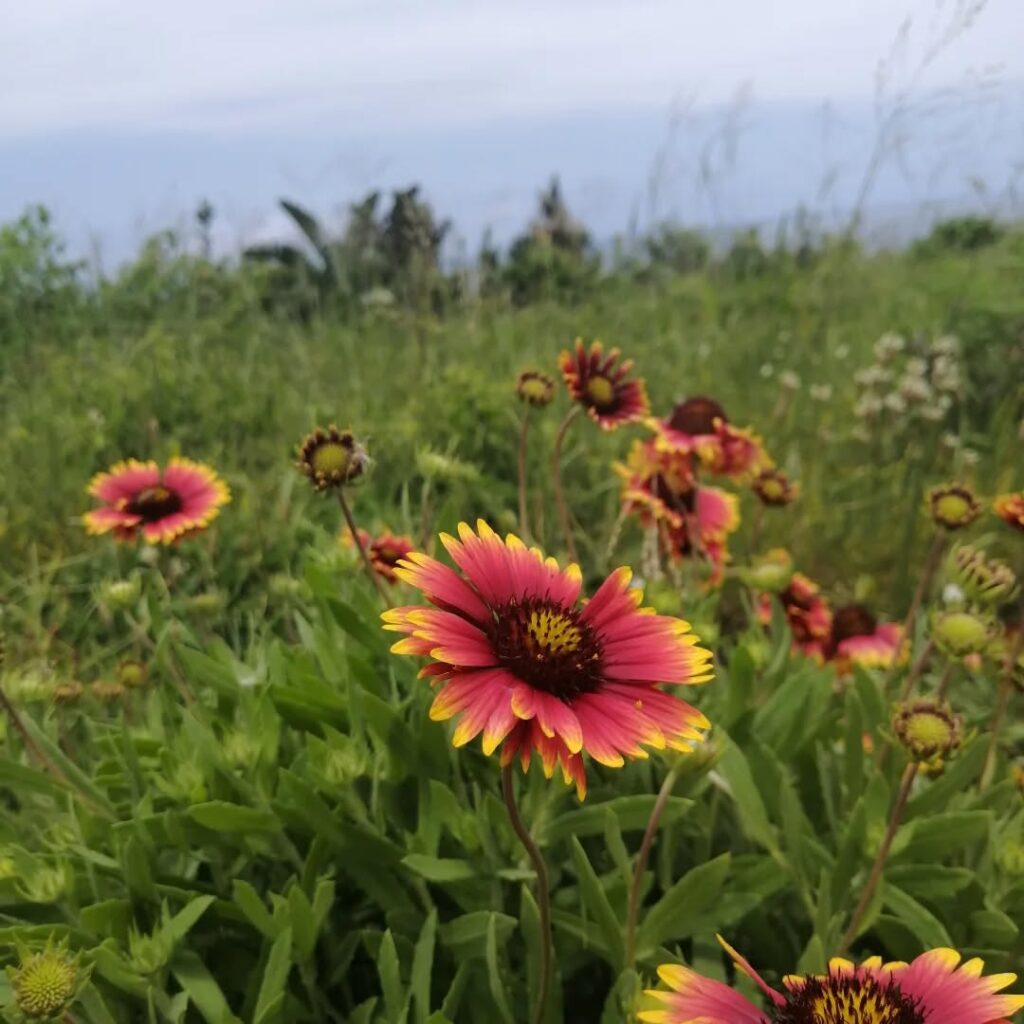
Indian Blanket Flower (Gaillardia pulchella) is a vibrant native wildflower that creates stunning displays across Eastern Oklahoma’s landscapes. This member of the daisy family produces distinctive bicolored blooms with red centers and yellow tips from spring through fall, reaching 1-2 feet in height. The common name reflects both its resemblance to traditional Native American blanket patterns and its tendency to blanket large areas with colorful flowers.
Beyond its ornamental appeal, Indian Blanket Flower serves as an ecological powerhouse, attracting butterflies, bees, and other pollinators while providing seeds for goldfinches and other birds. Its exceptional drought tolerance and ability to thrive in poor soils make it ideal for low-maintenance wildflower meadows, pollinator gardens, and naturalistic landscapes. The plant readily self-seeds, establishing persistent colonies that support local wildlife while requiring minimal care. The species is also remarkably salt tolerant, making it suitable for roadside plantings and coastal-influenced areas.
- Hardiness: USDA zones 5-9
- Light: Full sun to partial sun
- Water: Low water requirements; very drought tolerant once established
- Soil: Well-drained, sandy or coarse-textured soils; tolerates poor soil conditions
- Fertilizer: None required; thrives in nutrient-poor soils
- Pest/Disease Resistance: Excellent resistance; very few pest or disease issues
- Growth Rate: Moderate to fast; readily self-seeds for natural spread
Aromatic Aster
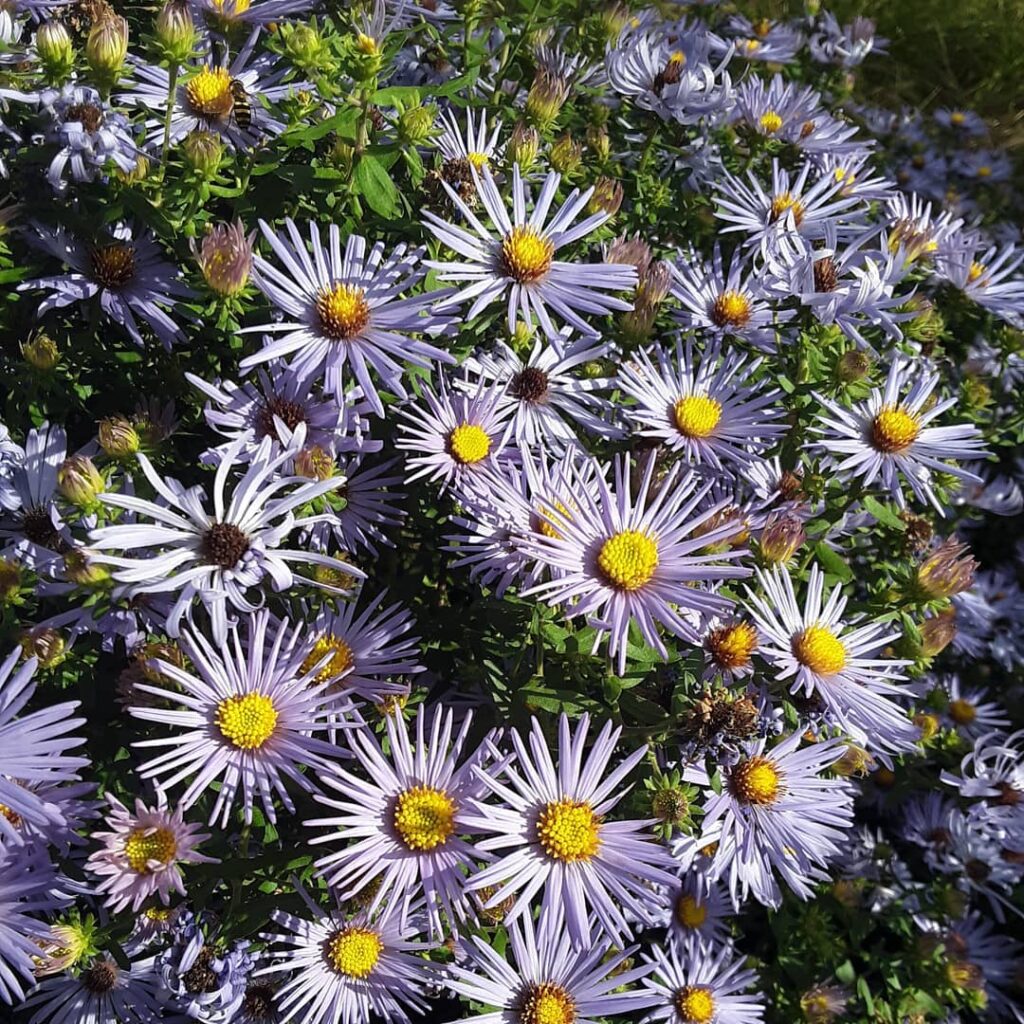
Aromatic Aster is a charming native wildflower that forms dense, low mounds 2-3 feet tall and wide. This late-blooming beauty produces masses of purple-violet flowers with bright yellow centers from late August through November, making it one of the last wildflowers to bloom each season. True to its name, the leaves release a distinctive sweet, pungent fragrance when brushed or crushed.
This hardy perennial thrives throughout eastern Oklahoma’s diverse conditions and spreads naturally through underground stolons, creating attractive colonies over time. Its exceptional drought tolerance and minimal care requirements make it perfect for low-maintenance gardens, prairie restorations, and naturalistic landscapes where it provides vital late-season nectar for pollinators. The plant can even tolerate some salt in the soil, adding to its adaptability in challenging growing conditions.
- Hardiness: USDA Zones 3-8
- Light: Full sun to partial shade
- Water: Low to moderate; drought tolerant once established
- Soil: Well-drained; tolerates poor, rocky, sandy, or average soils
- Fertilizer: Minimal to none required
- Pest/Disease Resistance: High; occasional powdery mildew in poor air circulation
- Growth Rate: Moderate; spreads by stolons to form colonies
Native Shade Trees
Eastern Oklahoma’s native shade trees offer diverse options for creating cool, comfortable outdoor spaces while supporting local ecosystems through wildlife habitat and natural adaptation to regional climate conditions. These trees create wildlife habitats attracting birds, bees, and butterflies to your property.
Eastern Red Cedar

Eastern Red Cedar is Oklahoma’s most widespread native evergreen, featuring a distinctive pyramidal form that can reach 60 feet tall. This hardy tree evolves from juvenile awl-shaped leaves to mature scale-like foliage and produces attractive light blue berry-like cones. Its bronze-red winter coloration and aromatic wood make it a popular choice for screening and windbreaks.
While valued for landscaping and wildlife habitat, Eastern Red Cedar requires careful consideration due to its aggressive spreading nature in grasslands. Fire suppression has allowed this naturally fire-protected species to colonize areas beyond its historical range, sometimes displacing native prairie vegetation. The tree’s reddish-brown bark naturally shreds into long strips, adding textural interest to the landscape.
- Hardiness: USDA zones 4-9, extremely tolerant of drought, heat, and cold extremes
- Light: Full sun to partial shade
- Water: Low to moderate water needs, drought tolerant once established
- Soil: Adapts to wide range from rocky uplands to bottomlands, prefers well-drained deep loam
- Fertilizer: Generally not needed, thrives in poor soils
- Pest/Disease Resistance: Very good resistance to most pests and diseases
- Growth Rate: Slow to moderate growth rate
Bur Oak

The Bur Oak is a magnificent native shade tree perfectly suited for Eastern Oklahoma’s climate. Known for producing the largest acorns of all native oaks, this slow-growing giant can live 200-300 years and reaches impressive heights. Also called blue oak or mossy-overcup oak, it’s extremely low-maintenance once established and requires minimal care. Its drought tolerance and adaptability make it ideal for Oklahoma’s variable weather conditions.
This majestic oak prefers deep, rich soils and full sun but adapts well to light shade. With proper spacing of at least 40 feet apart, mature trees develop extensive root systems equal in weight to their above-ground portions. The Bur Oak extends farther north than any other oak species, demonstrating exceptional hardiness and resilience in diverse conditions. The large acorns can reach up to 1.5 inches in diameter and provide valuable food for wildlife including songbirds and mammals.
- Hardiness: Extremely hardy, extends farther north than any other oak species
- Light: Full sun preferred, tolerates light shade better than most oaks
- Water: Drought-tolerant once established, deep watering needed first growing season
- Soil: Prefers deep, rich soils but adapts to various soil types
- Fertilizer: Slow-release fertilizer in early spring before new leaves appear
- Pest/Disease Resistance: Generally resistant with minimal issues
- Growth Rate: Slow, 1-2 feet per year
American Elm

American Elm is a majestic native deciduous tree distinguished by its graceful arching branches and distinctive vase-shaped crown. Also known as white elm or water elm, this extremely hardy species thrives throughout eastern Oklahoma’s diverse landscapes, from wet bottomlands and floodplains to well-drained hillsides and uplands.
This adaptable shade tree serves as a principal member of several forest communities and provides essential habitat for Oklahoma wildlife. While trees in southern regions like Oklahoma typically grow smaller with shorter lifespans compared to their northeastern counterparts, they benefit from higher survival rates due to less favorable conditions for Dutch Elm Disease. The tree produces distinctive flat, papery hulls that encase its seeds, making identification easier during the growing season.
- Hardiness: Extremely cold hardy, withstanding temperatures as low as -40°C (-40°F)
- Light: Full sun to partial shade
- Water: Moderate to high moisture; thrives in wet conditions but adaptable to various moisture levels
- Soil: Highly adaptable; prefers rich bottomlands and clay to silty-clay loams but grows well on various soil types
- Fertilizer: Low maintenance; thrives in naturally rich soils without supplemental feeding
- Pest/Disease Resistance: Higher resistance to Dutch Elm Disease in southern climates like Oklahoma
- Growth Rate: Medium on wet sites, good on well-drained sites
Pecan Tree
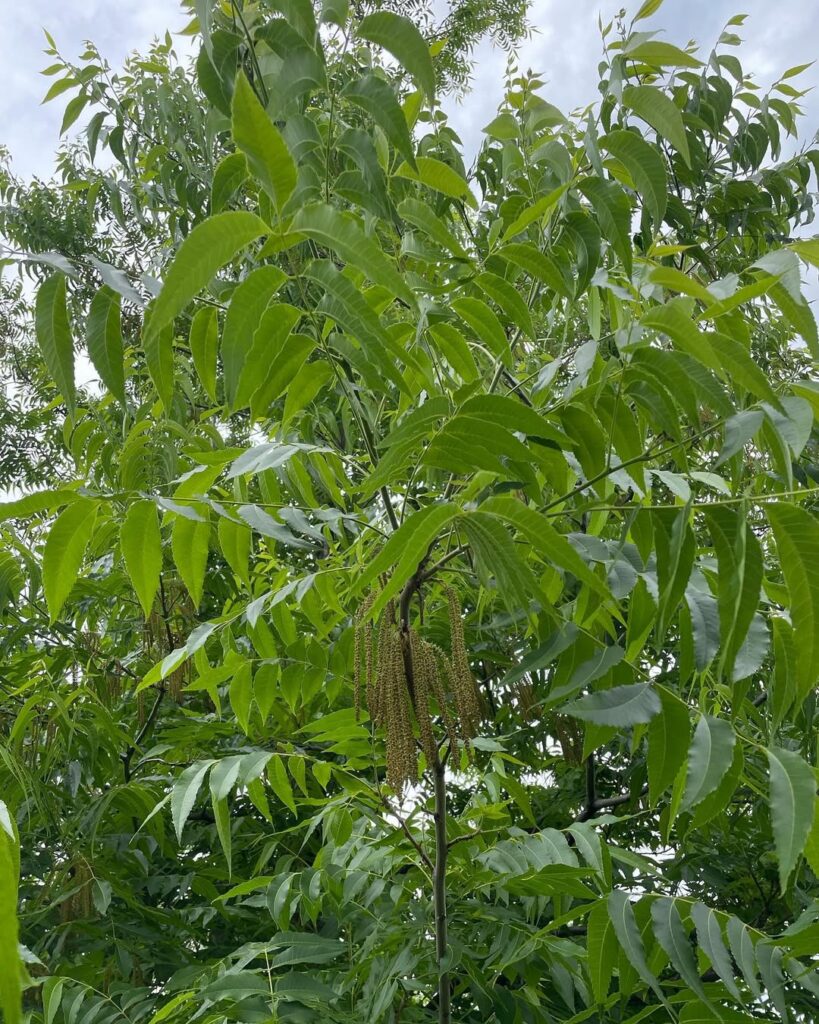
The pecan tree is a magnificent native shade tree that grows wild throughout eastern Oklahoma’s waterways and river bottoms. These majestic trees have deep historical significance, with American Indians being the first to recognize their value, and Spanish explorers documenting their presence in the 1500s. Pecan trees are monoecious, producing both male and female flowers on the same tree, though cross-pollination with other varieties improves nut production.
Oklahoma’s native pecans thrive in the state’s climate and have been cultivated extensively, with the Oklahoma Agriculture Experiment Station developing several cold-hardy varieties specifically adapted to local conditions. These long-lived trees provide excellent shade while producing nutritious nuts, making them valuable additions to rural and urban landscapes alike. For optimal cross-pollination, plant pollinators within 300 feet of each other to ensure adequate pollen availability during the female flower’s receptive period.
- Hardiness: Cold hardy in eastern Oklahoma, especially when grafted on northern rootstocks like Giles, Peruque, or Colby
- Light: Full sun preferred for ideal growth and nut production
- Water: Moderate to high water needs; naturally grows along rivers and streams with consistent moisture
- Soil: Well-drained loamy soils preferred; deep alluvial soils ideal; adaptable to various soil types
- Fertilizer: Benefits from regular fertilization, particularly nitrogen and zinc supplementation
- Pest/Disease Resistance: Generally hardy but may be susceptible to pecan weevil, aphids, and scab disease
- Growth Rate: Moderate to fast growth rate, especially on Apache rootstocks
Sugar Maple
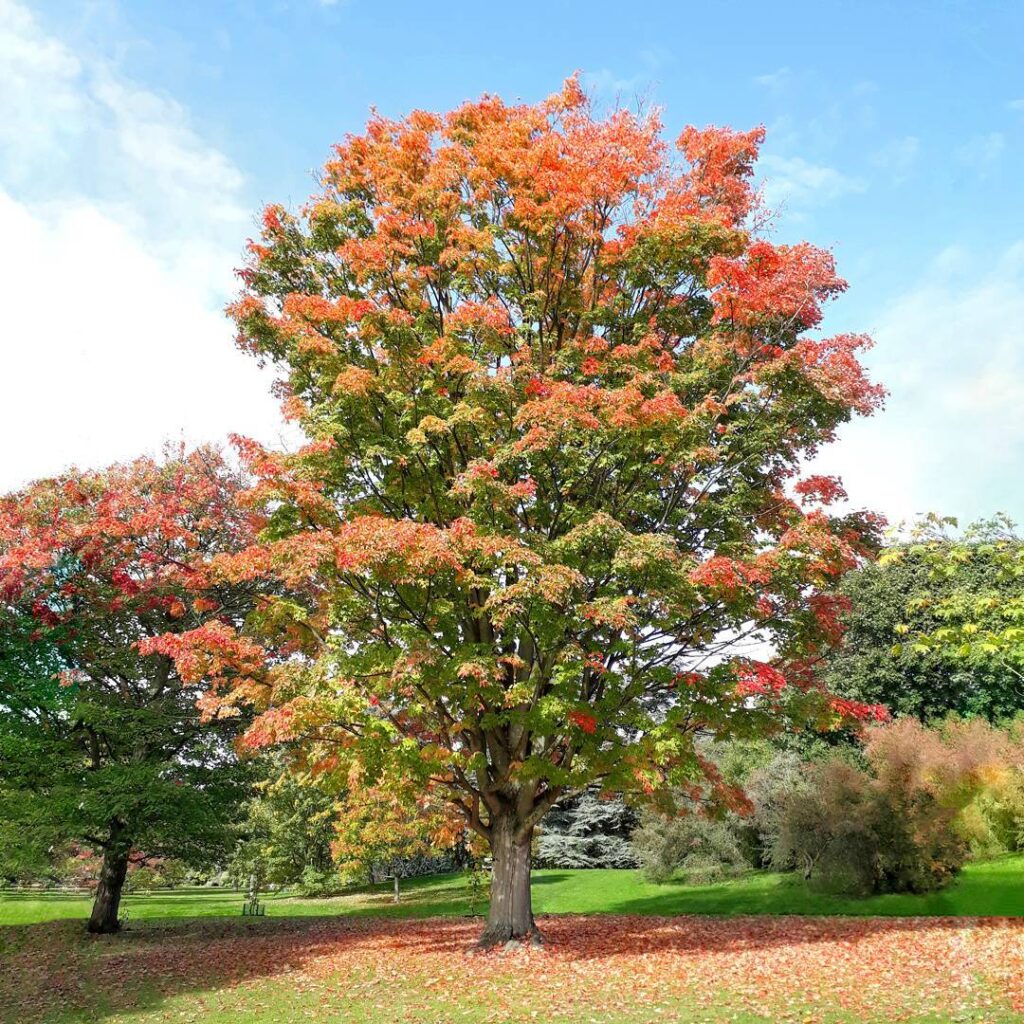
The Caddo Sugar Maple is a native Oklahoma treasure that provides exceptional shade and stunning fall color. This drought-tolerant maple adapts well to the challenging conditions of eastern Oklahoma, including rocky limestone soils and extreme heat. Unlike other maple species, it withstands periodic dry spells while developing strong, resilient wood through its slower growth pattern.
As a legacy tree, the Caddo Sugar Maple serves dual purposes in the landscape – offering dense summer shade that reduces energy costs and delivering spectacular autumn displays ranging from golden yellow to vibrant orange-red. Its deep root system and long lifespan make it an excellent investment for homeowners seeking a low-maintenance native shade tree that supports local wildlife and biodiversity. This impressive tree typically reaches a mature height of 30 to 50 feet, making it an ideal choice for medium to large shade applications.
- Hardiness: USDA Zones 5-9
- Light: Full sun for ideal growth and fall color
- Water: Drought tolerant once established; deep watering during establishment
- Soil: Adaptable to wide range including rocky limestone and high pH soils; prefers deep, well-drained soils
- Fertilizer: Minimal requirements as native species
- Pest/Disease Resistance: Good resistance; foliage resistant to leaf tatter and scorch
- Growth Rate: Slow to moderate, resulting in stronger wood structure
Native Shrubs for Wildlife Habitat
Native shrubs form the backbone of Oklahoma wildlife habitat, providing essential food sources, shelter, and nesting sites while requiring minimal maintenance once established in appropriate growing conditions. These plantings significantly enhance biodiversity in local ecosystems by creating interconnected habitats that support multiple species throughout the year.
American Beautyberry
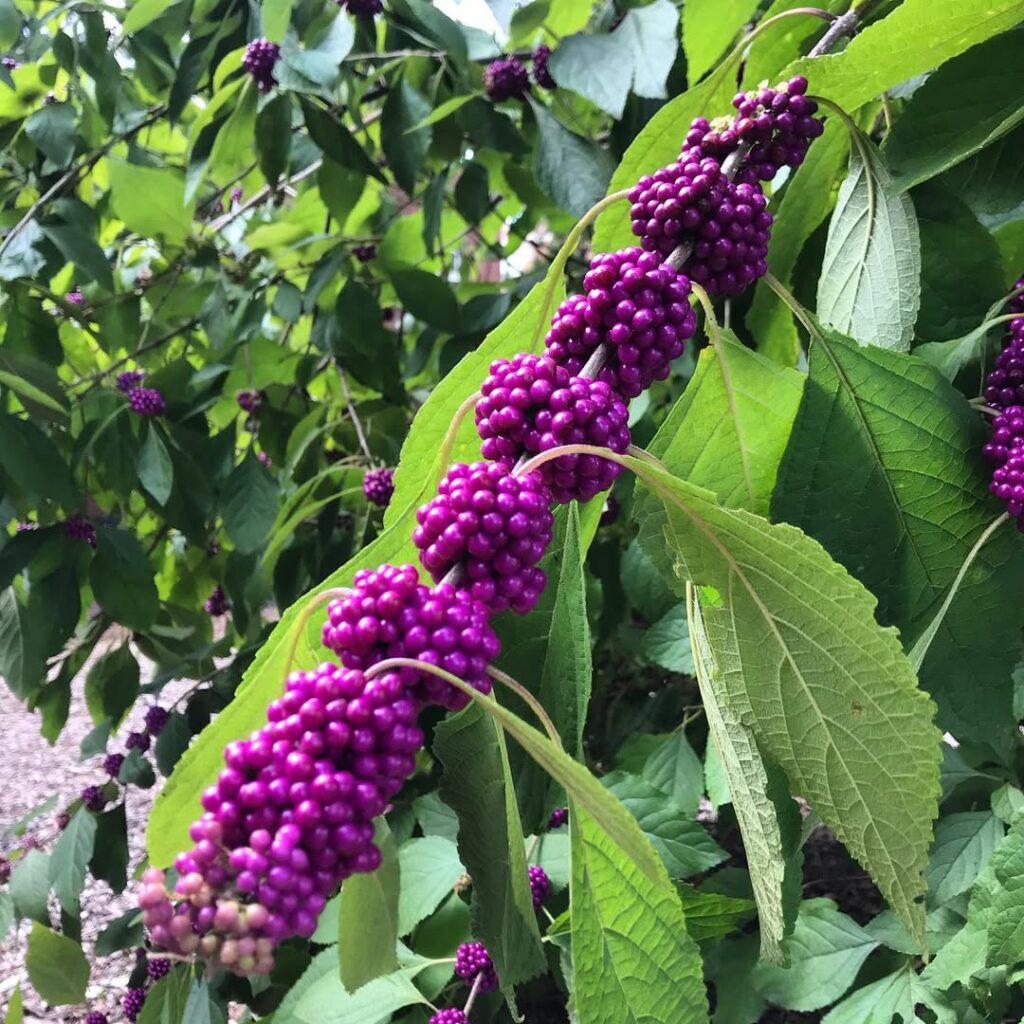
American beautyberry is a deciduous native shrub that grows 3-6 feet tall with long, arching branches and oval, serrated leaves. From June to August, it produces small pink to lavender flowers, followed by striking clusters of vivid purple or magenta berries that persist into winter. This adaptable shrub thrives in woodland edges, moist thickets, and bottomlands throughout eastern Oklahoma.
The shrub provides exceptional wildlife value, with its berries serving as essential fall and winter food for over 40 bird species including mockingbirds, robins, and finches. Mammals like deer, raccoons, and armadillos also browse the foliage and consume berries, while the dense branching structure offers cover for small mammals, birds, and beneficial insects. Its nectar-rich flowers attract native pollinators. The species is particularly valued as an important food source for Northern Bobwhite quail populations.
- Hardiness: Native to southeastern U.S. including eastern Oklahoma
- Light: Part-shade preferred, tolerates full sun to moderate shade
- Water: Drought tolerant once established, benefits from occasional moisture
- Soil: Well-drained loam or sandy soils, tolerates seasonal moisture variation
- Fertilizer: Minimal fertilization needs once established
- Pest/Disease Resistance: Relatively pest-free, rarely browsed heavily by deer
- Growth Rate: Moderate, easily maintained with minimal pruning
Spicebush
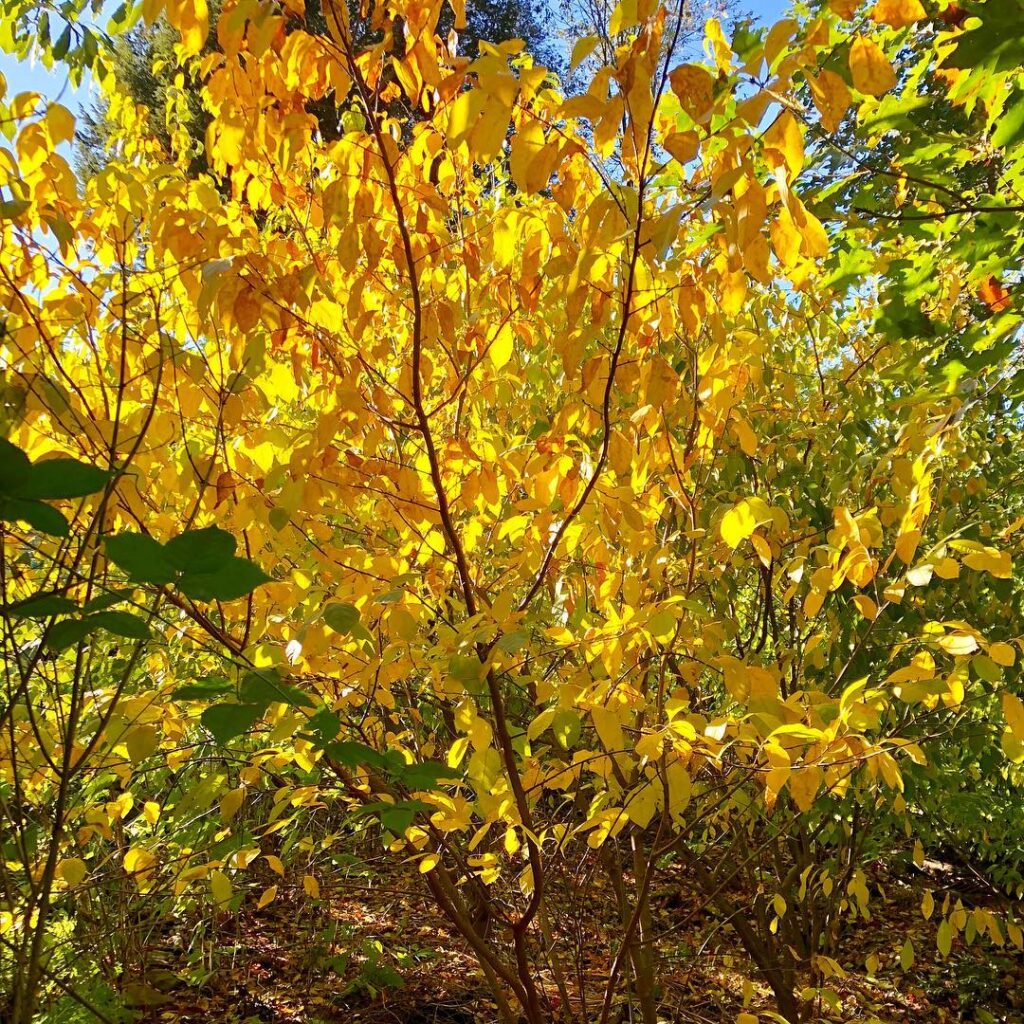
Spicebush is an excellent native shrub for eastern Oklahoma, reaching 6-12 feet tall with aromatic foliage and small yellow spring flowers. This deciduous shrub produces bright red berries on female plants (requires both male and female for fruit production) and offers exceptional wildlife value throughout the year.
The shrub serves as a vital host plant for Spicebush Swallowtail and Eastern Tiger Swallowtail butterflies while providing berries for migrating birds and nectar for early pollinators. Its dense branching structure offers shelter and nesting sites for small birds and mammals, making it an ideal choice for naturalizing shaded areas and creating wildlife corridors. The leaves turn golden-yellow in fall, adding seasonal interest to the landscape.
- Hardiness: USDA zones 4-9
- Light: Part shade to full shade (more sun increases fruit production)
- Water: Moist, well-drained soils preferred; tolerates dry to wet conditions
- Soil: Wide range including sandy loam, limestone-based, and caliche soils
- Fertilizer: Low maintenance, minimal fertilizer needs
- Pest/Disease Resistance: Generally free from serious disease and insect problems
- Growth Rate: Fast-growing
Elderberry
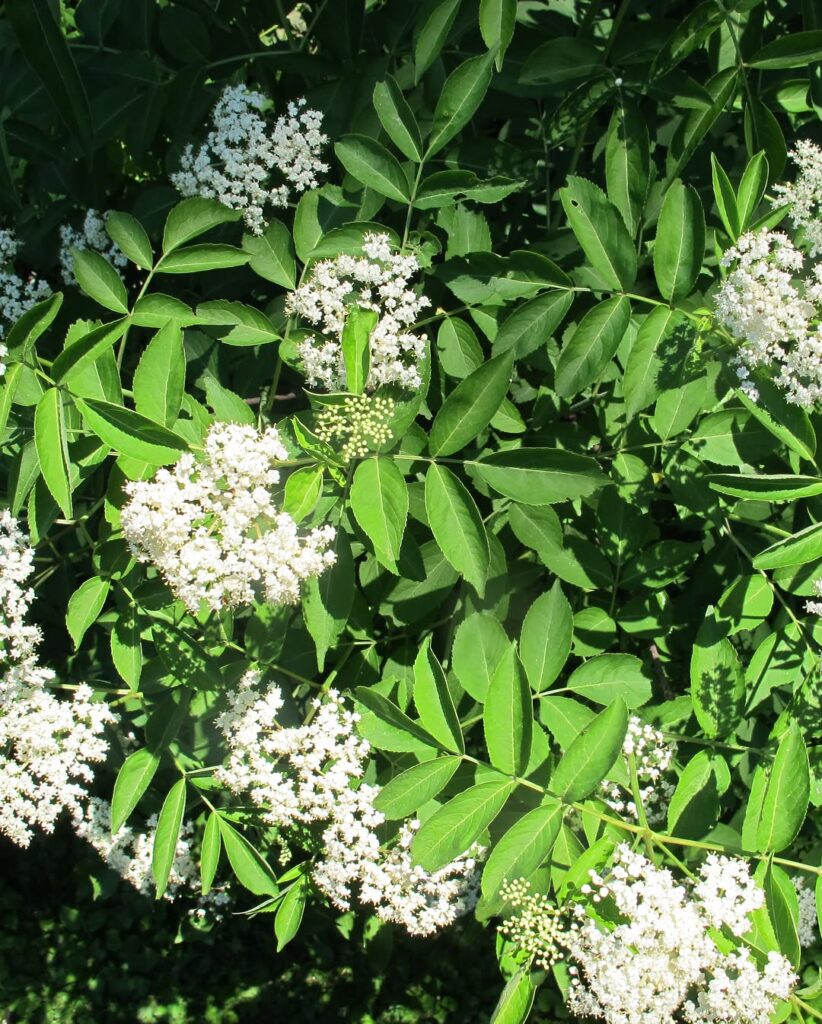
Elderberry is a deciduous perennial shrub native to Oklahoma that can reach up to 12 feet tall. This adaptable plant features opposite, pinnate leaves and produces clusters of white flowers in late spring, followed by purple-black drupes in fall. It’s one of the first woody plants to leaf out in spring and provides excellent wildlife habitat, serving as a host plant for many species while offering food and nesting sites for birds and small mammals.
The shrub thrives in various wet to dry conditions and spreads naturally by root suckers to form thickets. While not suitable for formal landscapes due to its somewhat unkempt appearance and suckering habit, elderberry excels in naturalized areas, rain gardens, and erosion control applications along streams and ponds. Mature plants that are three or more years old can yield 12-15 pounds of fruit per plant annually.
- Hardiness: Zones 3-9, well-adapted to Oklahoma’s climate
- Light: Full sun to partial shade, tolerates various light conditions
- Water: Moderate to high moisture needs, tolerates wet to dry soils
- Soil: Rich, moist, slightly acidic soils high in organic matter; avoid poorly drained areas
- Fertilizer: Low requirements, benefits from organic matter amendments
- Pest/Disease Resistance: Good air circulation needed to reduce disease problems
- Growth Rate: Fast-growing with vigorous spread by root suckers
Coral Honeysuckle

Coral Honeysuckle is a outstanding native vine that brings vibrant color and wildlife value to Eastern Oklahoma gardens. Its bright red tubular flowers bloom from spring through fall, attracting hummingbirds and butterflies while producing minimal fragrance. Unlike invasive Japanese honeysuckle, this well-behaved native creates dense foliage that provides excellent nesting sites for birds.
The plant produces bright red berries that feed numerous bird species including quail, finches, and robins. It serves as a larval host for Spring Azure butterflies and Snowberry clearwing moths, making it an essential component of native ecosystems. With proper support structures, Coral Honeysuckle creates spectacular living walls while tolerating challenging conditions like clay soil and deer browsing.
Coral Honeysuckle features distinctive opposite leaves that are variable in shape, with early leaves being linear and later leaves developing into oblong to elliptic forms.
- Hardiness: Zones 4-9
- Light: Full sun to partial shade; best flowering in full sun
- Water: Moderate; drought tolerant once established
- Soil: Well-drained, acidic to near-neutral; tolerates clay soil
- Fertilizer: Low maintenance; minimal fertilization needed
- Pest/Disease Resistance: Generally pest and disease free
- Growth Rate: Moderate to fast; 10-20 feet with support
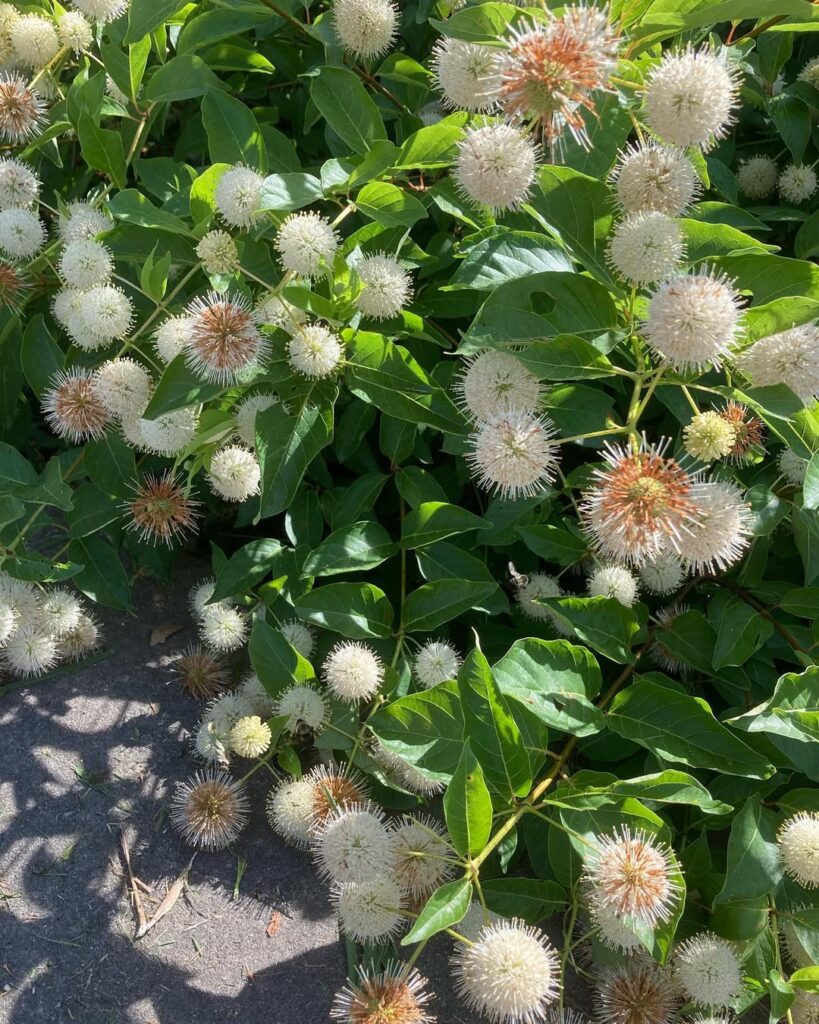
Buttonbush is a distinctive native shrub that serves as an excellent wildlife magnet for Eastern Oklahoma gardens. Growing 6-12 feet tall and wide, this deciduous shrub produces remarkable golf-ball sized, creamy-white spherical flowers that resemble pincushions with their protruding styles. The unique blooms attract numerous pollinators and hummingbirds, while the subsequent reddish-brown seed buttons provide winter food for waterfowl and songbirds.
One of the last shrubs to leaf out in spring, buttonbush thrives in Oklahoma’s challenging conditions from wet stream margins to drier upland sites. Its adaptability to various soil types and moisture levels, combined with exceptional resistance to pests and diseases, makes it an ideal low-maintenance choice for creating wildlife habitat while providing erosion control in difficult areas. The shrub features dark, glossy green foliage that provides attractive form throughout the growing season.
- Hardiness: Zones 5-9, cold-hardy and heat-tolerant
- Light: Full sun to partial shade
- Water: Average watering, tolerates both wet and dry conditions
- Soil: Adaptable to sand, loam, clay, and limestone soils; prefers moist, poorly drained conditions
- Fertilizer: Minimal requirements, low maintenance
- Pest/Disease Resistance: Excellent resistance to insects and diseases
- Growth Rate: Medium, reaching 6-12 feet tall and wide at maturity
Selecting the Right Native Plants for Your Garden
When you’re choosing native plants for your eastern Oklahoma garden, you’ll want to match each species to your specific site conditions for the best results. Group sun-lovers like Butterfly Weed and Indian Blanket in bright spots, while Black Samson Echinacea works well in partially shaded areas.
Plant companioning works beautifully with native grasses like Sand Bluestem mixed alongside colorful wildflowers. This creates natural biodiversity while supporting local wildlife.
For drought strategies, focus on proven performers like Lanceleaf Coreopsis and Partridge Pea. These species handle Oklahoma’s unpredictable rainfall patterns without constant watering, making your garden both sustainable and low-maintenance. Consider Arkansas Bluestar, which is native to eastern Oklahoma and provides excellent adaptation to local growing conditions.
Frequently Asked Questions
How Long Do Native Plants Take to Establish in Eastern Oklahoma?
You’ll need up to two years for most native plants to fully establish their root systems. The establishment timeline depends on growth factors like soil moisture, sunlight exposure, and proper planting timing during fall months.
What Time of Year Is Best for Planting Native Species?
You’ll find spring planting from March to May offers ideal conditions for most native species. Fall planting between August and October works well too, allowing root establishment before summer heat stress arrives.
Do Native Plants Require Fertilizer or Special Soil Amendments?
Like plants thriving in their ancestral home, you won’t need fertilizer for native species. Instead, consider fertilizer alternatives such as organic matter additions to boost soil health when establishing new plantings in challenging spots.
How Much Do Native Plants Typically Cost Compared to Non-Natives?
Native plant pricing runs higher upfront—you’ll pay $12-$18 for specialty perennials versus $2.50 for non-natives. However, this cost comparison shifts long-term since natives slash your maintenance expenses considerably.
Can Native Plants Survive Oklahoma’s Extreme Weather Events Like Ice Storms?
Picture your redbud tree bending gracefully during last winter’s ice storm while your neighbor’s non-native maple snapped. You’ll find native plants excel at ice storm resilience through superior weather adaptation mechanisms like flexible stems.
